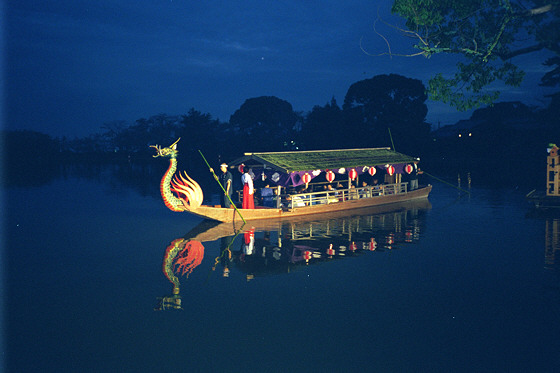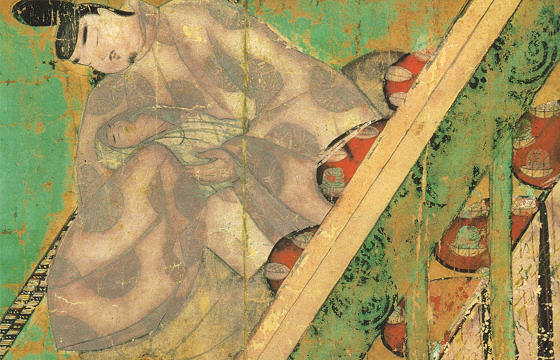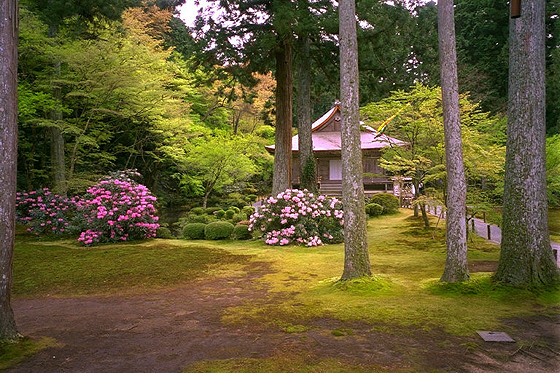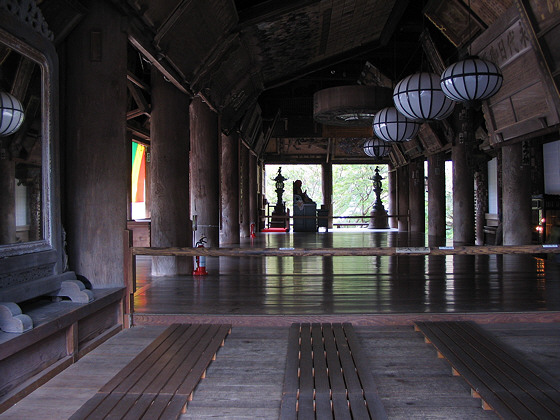Background of The Tale of Genji
Written just after the year 1000 A.D. by an aristocratic lady known today as Murasaki Shikibu, The Tale of Genji was immensely popular among the author's contemporaries in Heian Japan.

With the sound of flute and koto music over the pond and dragon boats under the harvest moon, this yearly festival at Daikaku-ji is as close as it gets to the courtly pastimes of Genji's day.
Murasaki wrote the Tale in 54 separate books which were avidly read by well-bred ladies of the time, as we know from the memoir As I Crossed a Bridge of Dreams (Sarashina Nikki), written by Lady Sarashina. There had never been anything like it.
Up to that point, Japanese literature had consisted mostly of collections of poetry written in the borrowed Kanji script of China. Prose was limited to fairy tales and a couple of memoirs written in the new phonetic syllabary known as kana. No one had ever written a novel, let alone a novel with character development and a complex plot.
The Heian period lasted from A.D. 794-1185. The emperor had moved the capital to Nagaoka from its previous location at Nara (then known as Heijo-kyo), to escape the overbearing influence of the Kegon sect of Buddhism. Ten years later, in 794, it was shifted again to Kyoto (Heian-kyo). It was a peaceful era with the emperor acting largely as a figurehead and centre of ceremonial activities while the real political power lay in the hands of the Fujiwara clan, the power behind the throne for 500 years.
Heian Society
The society depicted in the Tale is one of an elite group of aristocrats - perhaps 5,000 in all - uninterested in anything but their own leisure and with the emperor at the centre of their world. Obsessed with rank and breeding, they were acutely sensitive to the beauty of nature and the pleasures of music, poetry, calligraphy and fine clothing. Heian courtiers knew little of the world outside the capital and cared even less. They rarely travelled and considered the common people as almost sub-human.
The top three court ranks were the high court nobles (kugyo), while the fourth and fifth ranks were generally the provinical governor class, which was often sneered at because of its lower rank and the countrified behaviour or speech of those bureaucrats who had to spend time away from the capital. Murasaki herself was a Fujiwara and daughter of the governor of Echizen.
Although provincial governors might do well financially, they considered a three-year tour of duty in the provinces to be virtual exile. Their trips to and from the provincial capitals, together with religious pilgrimages, was about the only travel undertaken by Heian aristocrats. Travel was difficult and dangerous, and was generally shunned until the capital moved to Kamakura (near present-day Tokyo) in 1186 and the feudal period began.
Relationships
Heian ladies were supposed to be seen by only two men in their entire life: their father and their husband. They spent much of their adult life in dark rooms, hidden behind an array of screens, blinds and fans. If they went out at all it was in an ox-drawn carriage with a slit to peek out of. It's little wonder that these house-bound ladies were entranced by fantastic tales in the same way that English women were to become addicted to the Gothic novels of the eighteenth century.
And The Tale of Genji had it all - romance, travel, encounters with the supernatural, and a hero so perfect he seemed to belong in a bygone age.
A lady's only escape from a sedentary lifestyle was to undertake occasional pilgrimages to Shinto shrines or Buddhist temples. And to avoid the tedium of life at home, the only real option was to enter court service as a lady-in-waiting for the empress or another royal concubine. Ladies-in-waiting were free to pursue amorous liaisons with the gentlemen at court, which provides the setting for much of the first part of the Tale.
Heian gentleman were not very interested in a woman's physical beauty and rarely had an opportunity to see it. The only physical attribute of interest was a woman's hair, which had to be thick and longer than she was tall. The fascination with long hair was one reason why a woman's becoming a nun was regarded with such seriousness - it could never again grow to its full length. This explains why Genji refuses to let Murasaki (his de facto wife in the Tale) take the tonsure when she is ill.
A gentleman was mostly interested in a woman of impeccable breeding, who wrote beautiful poetry and was skilled at calligraphy. Clothing was very important too, and colours had to be perfectly matched. The fashion statement of the day was for ladies to let the overlapping sleeves of their multiple robes be seen protruding from under the edges of their screens or dangling gaily from their carriages. The sleeves attracted the man, and he would fall in love with the author of a sensitive and clever poem.
Male courtiers had plenty of time for pursuing women as their main duties were attending the emperor and little real administrative work was involved. Typically, high-ranking men were polygamous, with an arranged marriage to a principal wife for political reasons, plus several concubines and freedom to play the field. Seduction was largely a matter of getting behind the lady's screens - if she was unwilling - and then everything else followed pretty quickly. In fact, many of the seductions in the Tale could more accurately be described as rape, and some humorous episodes result on the rare occasions that a lady stubbonly defends her honour.

Genji holds the infant Kaoru (detail from the 12th century Genji Monogatari Emaki scroll).
A love affair consisted of the gentleman visiting his lady secretly at night and leaving with a tender farewell before dawn. It was de rigeur for the man to send a "morning-after poem" as soon as he arrived home, and much of the affair was conducted as an exhange of poems delivered by messengers. Inevitably, the ladies' poems wondered how long the man's interest would last and usually they were right in doubting his committment. In his early adventures, Genji seems rather selfish and unfeeling, but later we see him become a true Heian hero who takes care of his ladies even when he has lost interest in them.
One of the favourite pastimes of Genji and his contemporaries was boating on artificial lakes listening to flute and koto music. This tradition can still be seen on the night of the Harvest Moon at Daikaku-ji Temple in the Western Hills of Kyoto.
Religion
Japan's original native religion is now known by the modern term, Shinto. But it was originally a mixture of animism and the worship of tutelary clan deities, the most important being the imperial clan which was believed to be directly descended from Amaterasu, the sun goddess. Shinto has no scriptures and no doctrine.
Buddhism was introduced from one of the Korean kingdoms in 552 and opposed by two clans - the Mononobe and Nakatomi - but supported by the Soga family. With the help of Prince Shotoku Buddhism subsequently became well-established in Japan, but only among the aristocracy, and a number of cults developed around various Mahayana Buddhas, bodhisattvas and deities. Yakushi, the "medicine Buddha," was popular during the Nara period.
During the Nara period, the great temples of Nara and their sects flourished and became politically powerful, resulting in the capital being moved to Kyoto in 794 to escape the temples' meddling. The Heian period saw the growth of the Tendai sect brought from China by Saicho, and the Shingon sect brought from China by Kukai.
Tendai had a bit of everything, and Saicho established himself on Mount Hiei to the northeast of Kyoto, considered a dangerous direction according to geomancy. Acting as a protector of the capital, the Tendai sect became virtually the state religion and many of its abbots were of royal blood. Kukai established the Shingon sect on the remote Mount Koya but was well liked by the emperor. Although Shingon was an esoteric sect, something like the Tibetan Buddhist sects, its elaborate rituals and art were admired at court.
By the time Murasaki began writing the Tale, Heian aristocrats' religious activities included attending Shinto festivals, following the dictates of geomancers (the famous onmyoji or Yin-Yang master, Abe no Seimei was a contemporary of Murasaki's), going on Shinto and Buddhist pilgrimages, and participating in Buddhist rituals and devotions. The cult of Amida, the Buddha of Infinite Light, had become popular within Tendai because of the approach of the Buddhist "degenerate age" (mappo) due to begin in 1052. Then, it was believed, one could only be saved by the saving grace of Amida. Later, in the Kamakura period, Amidism evolved into the Pure Land (Jodo) sect and became popular with the masses.
Murasaki Shikibu herself was an Amidist and there are many references
to Amida and the Lotus Sutra in the novel. There are also references to
Kannon, the Bodhisattva of Compassion, who was believed to help those
suffering in this life while Amida saved them in the next. As can be
seen in the Tale, many Heian aristocrats took vows and retired to a
monastery later in life so they could earn merit by chanting or copying
sutras and prepare for entry into Amida's Western Paradise.
Sources:
- The Tale of Genji (Tyler)
- The Tale of Genji (Seidensticker)
- Tale of Genji : A Reader's Guide (analysis/summary of chapters)
- The World of the Shining Prince : Court Life in Ancient Japan
- Murasaki Shikibu, The Tale of Genji - A Student Guide (analysis)
- The Bridge of Dreams: A Poetics of the "Tale of Genji" (analysis)
- Ukifune : Love in the Tale of Genji
- The Gossamer Years (Kagero Nikki)
- As I Crossed a Bridge of Dreams (Sarashina Nikki)
- The Pillow Book of Sei Shonagon (Makura no Soshi)
- Tale of Flowering Fortunes : Annals of Japanese Aristocratic Life in the Heian Period (Eiga Monogatari)
- History of Japan to 1334
- Japan : A Short Cultural History
- The Buddhist Tradition : In India, China and Japan
- The Traveler's Guide to Japanese Pilgrimages

